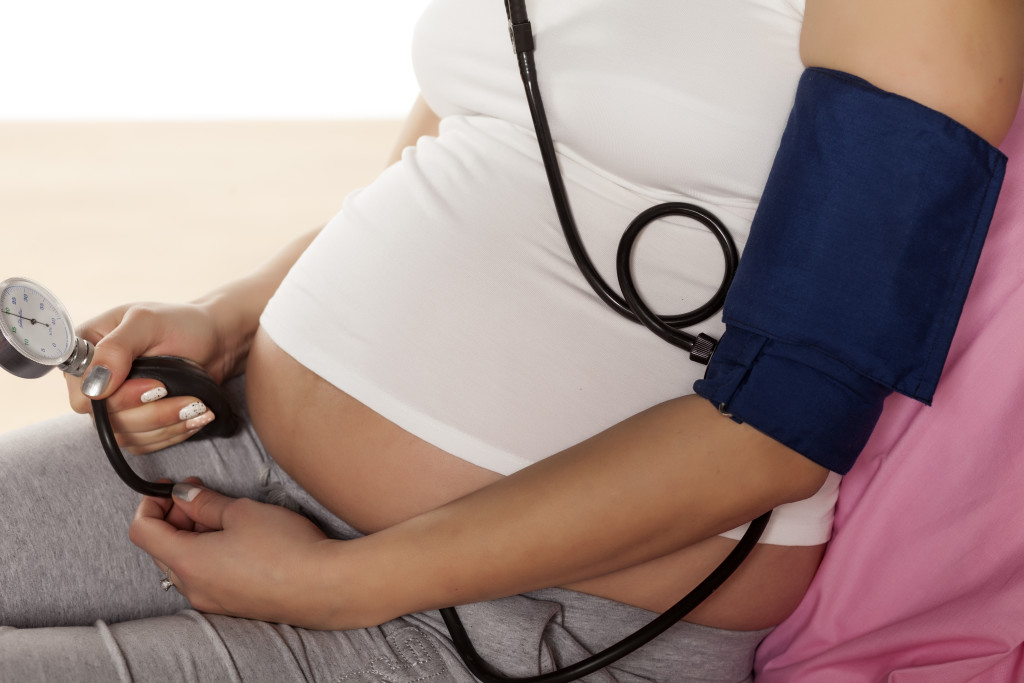By Iris Farrou
11 Feb, 2022
Women's Health
Best gyns in Buffalo, Best OB practices in Buffalo, Best OBGYN Groups in Buffalo, Buffalo OB-GYN, Buffalo OBGYN, Chouchani MD, Healthy pregnancy, Preeclampsia, WNY OB-GYN, WNY Ob-gyn doctors, WNY OBGYN, women's health, women's health tips
 As much joy as a pregnancy brings, there are also a lot of worries that accompany it. While preeclampsia may summon dated references like Lady Sybil’s death on Downton Abbey, it still affects women today. According to the CDC, 1 in 25 pregnancies in the United States are affected by preeclampsia—the sudden elevation of the mother’s blood pressure after the 20th week of pregnancy.
As much joy as a pregnancy brings, there are also a lot of worries that accompany it. While preeclampsia may summon dated references like Lady Sybil’s death on Downton Abbey, it still affects women today. According to the CDC, 1 in 25 pregnancies in the United States are affected by preeclampsia—the sudden elevation of the mother’s blood pressure after the 20th week of pregnancy.
What is it and what are the causes?
Preeclampsia usually begins after the 20th week of pregnancy, with some rare cases of postpartum preeclampsia. It is characterized by high blood pressure, as well as damage to the liver and kidneys. There may also be protein in the women’s urine and low levels of platelets. For a preeclampsia diagnosis, the mother’s blood pressure during pregnancy needs to be persistent and other symptoms of organ damage, low platelets, fluid in the lungs, and/or signs of brain trouble need to be present.
The causes of preeclampsia have not yet been precisely identified. However, potential causes include genetic factors, blood vessel problems, and chronic hypertension, as well as metabolic diseases or autoimmune disorders. There are some known risk factors that may increase the chances of preeclampsia, such as:
- history of preeclampsia in your family
- preeclampsia in a previous pregnancy
- having a multiple pregnancy or becoming pregnant via IVF
- being over the age of 40
- having obesity
- being pregnant for the first time
How Can it be Treated?
To receive a diagnosis and treatment, watch out for the following symptoms:
- signs of kidney problems and excess protein in your urine
- severe headaches and changes in vision
- upper abdominal pain
- nausea or vomiting, as well as shortness of breath
Some symptoms may go unnoticed, such as sudden weight gain and swelling, since they are normal symptoms of a pregnancy, so watch out for a combination of symptoms and attend all your prenatal appointments to ensure you and your baby’s safety.
With preeclampsia, you are at increased risk of seizures, stroke, severe bleeding, and placental abruption. As such, the most effective treatment is delivery. Possible medications may include antihypertensives to help lower your blood pressure, corticosteroids that can temporarily improve liver and platelet function, as well as anticonvulsant medications to prevent seizures. Severe cases of preeclampsia may require you to be hospitalized, but by far the most effective treatment is delivery of the baby. Be wary of the traditional suggestion of “bed rest,” as in this case it can actually be more harmful since it increases the risk of blood clots.
More
 If you’re pregnant or about to become pregnant, your number one priority is carrying your baby safely and healthily to full-term. No matter what your current state of health, or how prepared you feel you are to have a healthy pregnancy, every new mom should understand the warning signs of high-risk pregnancies.
If you’re pregnant or about to become pregnant, your number one priority is carrying your baby safely and healthily to full-term. No matter what your current state of health, or how prepared you feel you are to have a healthy pregnancy, every new mom should understand the warning signs of high-risk pregnancies.
What is a high-risk pregnancy?
Generally, a pregnancy is defined as high-risk if you or your baby has an increased chance of facing a health problem. Such problems could be caused by one of several underlying conditions, including:
These conditions put you and your baby at risk for complications like slowed fetal growth, a preterm labor, preeclampsia, or issues with the placenta.
Other factors that could result in a high-risk pregnancy include:
- If you are under 17 or over 35
- You use alcohol or illegal drugs
- You smoke
- You have an infection, such as HIV, hepatitis C, syphilis, cytomegalovirus (CMV), chickenpox, rubella, or toxoplasmosis
- You are having a multiple pregnancy
- You have had three or more miscarriages
- Your baby has been diagnosed with a genetic condition such as Down syndrome, or a heart, lung, or kidney condition
- You have been diagnosed with a serious condition such as heart valve problems, sickle cell disease, asthma, lupus, or rheumatoid arthritis
- You have had a serious problem with a previous pregnancy, such as a preterm labor, preeclampsia, or seizures (eclampsia)
- You are taking certain medications such as lithium, valproic acid, or carbamazepine
High-risk pregnancy treatment
Your OB-GYN will be able to diagnose whether or not your pregnancy is high-risk. If you are diagnosed as being high-risk, you should expect more frequent visits to your doctor than women whose pregnancies are not high-risk. Your OB-GYN will likely want you to receive more frequent ultrasound tests to confirm your baby is developing and growing at the proper rate. Your doctor will also closely monitor your blood pressure and more frequently test your urine for a protein that indicates preeclampsia or a urinary tract infection. If you have diabetes, asthma, or high blood pressure, your doctor may prescribe medications to help monitor such conditions.
Keep in mind that just because your pregnancy has been defined as high-risk does not mean that your baby will definitely be born with health issues. Under the care of your OB-GYN, and by following your prescribed treatment plan, you can welcome your new, healthy baby into the world without worry.
More
 During pregnancy women experience a wide range of physical changes and sensations. The signs of preeclampsia, a disorder that occurs only during pregnancy and the postpartum period, are too often misinterpreted as the symptoms of a normal pregnancy. Preeclampsia generally occurs late in the second or third trimesters, and up to six weeks postpartum. In rare cases it can occur before the second trimester begins. It is estimated that approximately three to five percent of pregnant women suffer from preeclampsia. Globally, preeclampsia and other hypertensive disorders of pregnancy are responsible for 76,000 maternal and 500,000 infant deaths every year. The symptoms can progress rapidly, and in the most severe cases, the results can be fatal. Understanding the signs of this dangerous condition will help keep you and your baby safe.
During pregnancy women experience a wide range of physical changes and sensations. The signs of preeclampsia, a disorder that occurs only during pregnancy and the postpartum period, are too often misinterpreted as the symptoms of a normal pregnancy. Preeclampsia generally occurs late in the second or third trimesters, and up to six weeks postpartum. In rare cases it can occur before the second trimester begins. It is estimated that approximately three to five percent of pregnant women suffer from preeclampsia. Globally, preeclampsia and other hypertensive disorders of pregnancy are responsible for 76,000 maternal and 500,000 infant deaths every year. The symptoms can progress rapidly, and in the most severe cases, the results can be fatal. Understanding the signs of this dangerous condition will help keep you and your baby safe.
Symptoms
Preeclampsia can be particularly dangerous because many of the signs are unidentifiable or misunderstood to be normal effects of pregnancy. Speak with your OBGYN if you experience any of the following:
- High blood pressure (Hypertension). High blood pressure is one of the most important indicators of preeclampsia, however it can easily go unrealized since women cannot feel their blood pressure rising. High blood pressure is generally defined by a reading of 140/90 or greater, measured on two separate occasions six hours apart. During pregnancy, a rise in the lower number of 15 degrees or more, or a rise in the upper number of 30 degrees or more, can be a cause for concern. Your OBGYN will help you keep a record of your blood pressure before and during your pregnancy to help identify an unsafe rise.
- Protein in your urine (Proteinuria). Protein in your urine can occur when proteins that are normally confined to your blood spill into your urine. Preeclampsia temporarily damages the filtering of blood by your kidneys, which causes the leakage of proteins into your urine. To identify this symptom, your OBGYN will test your urine at each prenatal check-up. In between visits if your urine appears to look dark, reddish, or the color of cola, contact your OBGYN immediately.
- Changes in vision. Vision changes are one of the most serious symptoms of preeclampsia. It may be an indication of irritation of the central nervous system or swelling of the brain (cerebral edema). If you experience sensations of flashing lights, auras, light sensitivity, or blurry vision or spots, contact your OBGYN or go directly to the hospital.
- Swelling (Edema). Some swelling is normal and common for pregnant women, however edema is the accumulation of excess fluid that occurs in the face, hands, or around the eyes. Contact your OBGYN if you notice excessive puffiness in your face, hands, or feet. Also, watch for signs of “pitting edema.” When you press your thumb into your skin, if an indentation remains for a few seconds, or you notice discoloration of your legs, you may be experiencing pitting edema and should contact your OBGYN right away.
- Headaches. Severe or dull throbbing headaches that won’t go away could be a sign of preeclampsia. If over-the-counter medicine does not relieve your symptoms, you have light sensitivity, you experiences changes in your vision, or the pain becomes severe, contact your OBGYN.
- Nausea or vomiting. Many women experience morning sickness, however nausea or vomiting that is sudden, and that occurs after mid-pregnancy could be a sign of preeclampsia.
- Abdominal (epigastric) pain and or shoulder pain. Both abdominal pain and shoulder pain, often called “referred pain” because it radiates from the liver under the right ribs, can be confused with heartburn, gallbladder issues, the flu, indigestion or the baby kicking. If the pain is associated with preeclampsia it will be more severe than the pain experienced with muscle strain. Shoulder pain may feel like you are being deeply pinched along the bra strap, on your neck, or your right side. Such pain could be related to an issue with your liver, so contact your OBGYN immediately if your pain seems abnormal or severe.
- Lower back pain. Again not to be confused with general muscle fatigue, lower back pain that is severe may be an indication of an issue with the liver, especially when accompanied by other signs of preeclampsia.
- Sudden weight gain. Many women are hyper-aware of changes in their weight during pregnancy, especially as they watch their baby bump grow and expand with each month. Rapid weight gain, however, could be a cause for concern. Weight gain of more than two pounds in a week could be an indicator of preeclampsia. The rapid increase could be caused by damaged blood vessels allowing more water to leak into body tissues instead of passing through to the kidneys.
- Hyperreflexia. Hyperreflexia is characterized by reflexes that are so strong that when your knee is tapped by a rubber hammer, your leg bounces back hard. It is typically caused by an overreaction of the involuntary nervous system to stimulation. Your OBGYN will test you for hyperreflexia; otherwise it may be difficult to identify on your own.
- Shortness of breath and anxiety. Having moments of nervousness during pregnancy is common, however women should pay attention to more severe signs of anxiety, such as shortness of breath, a racing pulse, mental confusion, and a heightened sense of anxiety. Contact your OBGYN if these symptoms come on immediately or severely.
Preeclampsia Treatment and Prevention
Proper prenatal care is essential to manage the risk of preeclampsia. Attend all scheduled OBGYN visits to make sure you are getting regular weight checks, blood pressure readings, and urine tests. Maintain a healthy diet full of vitamins, and natural, rather than processed, foods. Most importantly, pay attention to your body. While every feeling you experience may seem sudden and strange, trust your instincts. Any rapid or severe changes or symptoms should be taken seriously.
Never hesitate to contact your OBGYN with questions or concerns. And if you are looking for at top OBGYN group in Western New York, please give our practice of Chouchani, Sayegh and Bagnarello a call today.
More
 As much joy as a pregnancy brings, there are also a lot of worries that accompany it. While preeclampsia may summon dated references like Lady Sybil’s death on Downton Abbey, it still affects women today. According to the CDC, 1 in 25 pregnancies in the United States are affected by preeclampsia—the sudden elevation of the mother’s blood pressure after the 20th week of pregnancy.
As much joy as a pregnancy brings, there are also a lot of worries that accompany it. While preeclampsia may summon dated references like Lady Sybil’s death on Downton Abbey, it still affects women today. According to the CDC, 1 in 25 pregnancies in the United States are affected by preeclampsia—the sudden elevation of the mother’s blood pressure after the 20th week of pregnancy.

